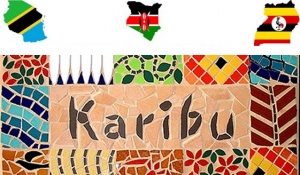Language/Swahili-individual-language/Vocabulary/Geography-and-Landscapes
| ◀️ Environmental Issues — Previous Lesson | Next Lesson — Ramadan and Eid al-Fitr ▶️ |
Introduction[edit | edit source]
Welcome to the lesson on Swahili vocabulary related to geography and landscapes! In this lesson, we will explore the diverse geography of East Africa and learn the Swahili names for various geographical features such as mountains, rivers, and deserts. Understanding the vocabulary related to nature and the environment is essential for effective communication in Swahili, especially if you plan to travel or interact with Swahili-speaking communities. So, let's dive in and discover the beauty of East Africa's geography through the Swahili language!
East African Geography[edit | edit source]
East Africa is renowned for its breathtaking landscapes and diverse geography. From the towering peaks of Mount Kilimanjaro to the vast Serengeti plains, the region offers a wealth of natural wonders. The Swahili language, spoken widely in East Africa, reflects this rich natural heritage. By learning the Swahili names for various geographical features, you will not only expand your vocabulary but also gain a deeper appreciation for the region's natural beauty.
Mountains[edit | edit source]
East Africa is home to some of the highest mountains in Africa, including Mount Kilimanjaro, Mount Kenya, and the Rwenzori Mountains. Let's learn the Swahili names for these majestic peaks:
| Swahili (individual language) | Pronunciation | English Translation |
|---|---|---|
| Mlima Kilimanjaro | MLEE-mah kee-lee-mah-NAH-roh | Mount Kilimanjaro |
| Mlima Kenya | MLEE-mah KEN-yah | Mount Kenya |
| Milima ya Rwenzori | MEE-lee-mah yah rwen-ZOH-ree | Rwenzori Mountains |
In addition to these famous mountains, there are many other peaks scattered throughout East Africa. Here are a few more Swahili mountain vocabulary words:
- Mlima - Mountain
- Mlima mrefu - Tall mountain
- Mlima mdogo - Small mountain
- Mlima wa volkeno - Volcanic mountain
Rivers[edit | edit source]
East Africa is crisscrossed by numerous rivers, which play a vital role in the region's ecosystems and provide water for both wildlife and human communities. Let's explore some Swahili vocabulary related to rivers:
| Swahili (individual language) | Pronunciation | English Translation |
|---|---|---|
| Mto Nile | MTOH NEE-leh | Nile River |
| Mto Rufiji | MTOH roo-FEE-jee | Rufiji River |
| Mto Tana | MTOH TAH-nah | Tana River |
Here are a few more river-related vocabulary words in Swahili:
- Mto - River
- Mto mkubwa - Big river
- Mto mdogo - Small river
- Kando ya mto - Riverside
- Mdomo wa mto - River mouth
Deserts[edit | edit source]
Though not as prominent as mountains and rivers, deserts also feature in East Africa's geography. The Swahili language has words to describe these arid landscapes:
| Swahili (individual language) | Pronunciation | English Translation |
|---|---|---|
| Jangwa la Sahara | JANG-wah lah sa-HA-rah | Sahara Desert |
| Jangwa la Namib | JANG-wah lah NAH-meeb | Namib Desert |
| Jangwa la Kalahari | JANG-wah lah ka-la-HA-ree | Kalahari Desert |
Here are a few more desert-related vocabulary words in Swahili:
- Jangwa - Desert
- Jangwa kubwa - Big desert
- Jangwa dogo - Small desert
- Jangwa lenye mchanga - Sandy desert
- Jangwa lenye mawe - Rocky desert
Cultural Insights[edit | edit source]
Geographical features hold significant cultural value in East Africa. They have shaped the lives, traditions, and beliefs of the people who inhabit these regions. For example, Mount Kilimanjaro, known as "Mlima Kilimanjaro" in Swahili, is not only a popular tourist destination but also holds spiritual significance for the local Chagga people. The Chagga believe that their ancestors reside on the mountain, and it is considered a sacred place.
Rivers, such as the Nile and Rufiji, have played crucial roles in the development of civilizations in East Africa. They have provided a source of water for agriculture, transportation, and trade. In Swahili culture, rivers are often associated with life, fertility, and abundance.
Deserts, on the other hand, have shaped the nomadic lifestyle of certain communities in East Africa. The Kalahari Desert, for instance, is home to the San people, who have adapted to the harsh desert environment and developed unique survival skills. Swahili culture, being more coastal and less desert-oriented, does not have a direct connection with deserts, but the Swahili language still includes vocabulary to describe these landscapes.
Practice Exercises[edit | edit source]
Now that we have explored the geography and landscapes of East Africa in Swahili, let's test your knowledge with some practice exercises. Translate the following English words into Swahili:
1. Mountain 2. River 3. Desert 4. Tall mountain 5. Big river
Answers:
1. Mlima 2. Mto 3. Jangwa 4. Mlima mrefu 5. Mto mkubwa
Conclusion[edit | edit source]
Congratulations! You have completed the lesson on Swahili vocabulary related to geography and landscapes. By learning the Swahili names for mountains, rivers, and deserts, you have gained a deeper understanding of East Africa's natural beauty and cultural significance. Keep practicing and exploring the Swahili language to expand your vocabulary and enhance your language skills. Asante sana (thank you very much) and kwaheri (goodbye)!
Other Lessons[edit | edit source]
- Idiomatic Expressions
- Countries and Continents
- Animals
- Days, Months, and Seasons
- Nature
- How to say Good Bye?
- Farm
- Hobbies
- Games
- Clothes
| ◀️ Environmental Issues — Previous Lesson | Next Lesson — Ramadan and Eid al-Fitr ▶️ |

